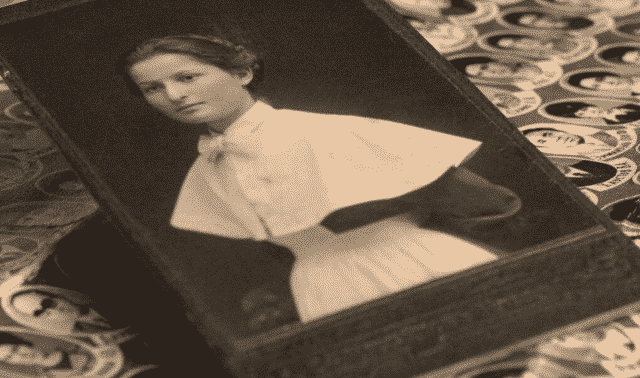How do you identify a family photograph if you don’t even know what side of the family the image belongs to? The answer is to look for physical features that distinguish one side from the other. In Rita Werner’s case, the striking resemblance between two women in her photograph collection leaves no doubt to a family relationship. At age 76, Grandmother Bernice (Figure 2) would look just like her unidentified ancestor (Figure 1) if she were wearing a daycap. With the family line identified, Rita wants to know who is in the first photograph and when it was taken.
The photographer’s imprint, C.H. Scofield of Utica, N.Y., is one clue. An online search reveals that a C.H. Scofield took stereoscopic pictures of Utica c. 1866-1900. You can view them on The Library of Congress American Memory site at memory.loc.gov. A photographer named C.H. Scofield (alternate spelling, Scholfield) also appears in Utica city directories from 1874 to at least 1889. He bragged in one city directory advertisement that he was the only photographer in Utica with rooms on the first floor. In the days before flash photography, natural light was an important component in taking a portrait, so most studios were on the top floor. Having a studio accessible without climbing stairs, he probably attracted an older clientele much like the woman in Figure 1.
It is possible to narrow the time period of the photograph based on appearance. Yellow cards with rounded corners were popular for photographs between 1871 and 1874, according to William C. Darrah’s Cartes de Visite: In Nineteenth Century Photography. The woman in Figure 1 is wearing a daycap with ruffles on the sides, an indication of her conservative approach to fashion (see my earlier column,”Daycaps,” for other daycap styles). Women’s magazines of the nineteenth century suggested that only young women should dress fashionably because older, married women had other concerns—those of home and family. But no matter how old-fashioned a woman’s dress, an attention to detail showed her awareness of current fashion. For instance, in this image, the woman wears a neck ribbon with a charm attached, as was the fashion in the 1870s. Her black dress, while simple in design, features some trim around the wrists and at the end of the jacket. The presence of the neck ribbon and the style of photograph suggest this image was taken in the early 1870s.
Werner suspects this woman is her fourth-great-grandmother, the grandmother of Thomas R. Connor (1848-1934). Connor was born in Ireland and immigrated to the United States in 1870. According to family legend, either Connor’s maternal or paternal grandmother raised him after his father, a merchant seaman, died at sea. It is possible that his grandmother immigrated with him, but this photograph might be the only evidence. A family photograph album does list a Mrs. E. Connor in the index. This mention could refer to the woman in the image and would support the family story. Werner also knows of an Elizabeth Connor (1814-1903) buried in a Utica cemetery, and she is trying to ascertain her origins.
Rita Werner may never be able to identify the woman in Figure 1, but one thing is certain. She is a relative. A quick glance at the two photographs she submitted leaves no doubt about it.
Find out how to submit your own picture for possible analysis by Maureen Taylor. E-mail her at mtaylor@taylorandstrong.com.



